Matthew Bostock Foundation Production
Friday, 25 January 2013
Wednesday, 23 January 2013
Q1: In what ways does your media product use, develop or challenge forms and conventions of real media products?
A thriller is a genre of novel, play or movie with an
exciting plot, which typically involves death of a character, and an element of
investigation into the death. The plot usually takes the characters on a
journey, which is usually based in cities towns.
Our thriller is based on the psychological and action
sub-genres. Before starting our thriller, we had carried out lots of research,
looking at many different thriller movies, and as a group, we thought that a
thriller in this style would be the best. We liked the idea of having a
psychological thriller, as it allows a more complex plot to unwind throughout
the film. We asked 10 people for their views on the thriller genre, aged
between 11-25, by giving them a questionnaire, which asked them about genre,
and which sub-genre of thriller they preferred. From the market research we carried
out, we could see that people enjoy watching a film with a more complex plot,
where it takes a while to work out what is happening. Also, action is something
that is found in a lot of the films we watched, so we thought it best to
include an element of this within our production.
With this genre we have chosen, the audience expect things to
be slightly abnormal. We needed to come away from stereotypes – the typical
‘good guy, bad guy’ approach is something that we needed to avoid, as the
audience would expect something slightly more advanced. From all of the
thrillers that we have watched, the narrative has never been based around the
relationship between two cousins, which is why we chose to explore this option.
We used narration to try and give the audience an insight into the plot, which
is something that is usually done in a psychological thriller.
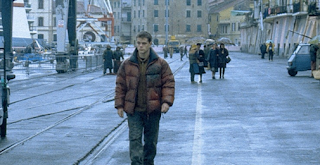
We used many props in our production, to make the film seem
more realistic. We used some flowers for the mourner to lay on the grave, as
this allowed us to portray what the actor was doing, without having to make it
clear in the voiceover. We also used a rope for the killer to tie the victim to
the train line with, along with a balaclava, to disguise his face both from the
camera, and from the victim. Furthermore, train planks were used to allow us to
write the titles/credits of the film onto the train. The planks gave an
authentic feel, and allowed us to move away from simply using titles on the
editing package – something that is done in a lot of thrillers, and by breaking
away from this convention, it would add the element of surprise to the
audience.
For our thriller opening, we used a track called ‘Gloom
Horizon’, available from royalty free music website www.incompetech.com. This was a track that mainly consisted of strings, with a strong beat
underneath the track, and an electric synthesizer effect was also added. From
all of the films we have watched, such as The Butterfly Effect, the music for
the opening section was quite a strong, punchy track, which was there to steal
the audience’s attention, and the pace of the music strongly reflected the pace
of the on-screen action. Therefore, we felt that this track would be entirely
appropriate for our thriller opening.
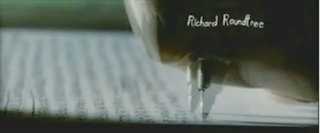 From the research that we had carried
out, we learnt that there are many conventions used to make the opening of the
thriller effective. One of the key elements of the opening, in my opinion, is
that it does not give too much detail away too soon within the film. For
example, the shot above is taken from the opening of Se7en, which often
features close up shots of objects, which makes the audience wonder what it is
actually showing. This ensures that the audience want to keep watching the
film, to see how it will develop.
From the research that we had carried
out, we learnt that there are many conventions used to make the opening of the
thriller effective. One of the key elements of the opening, in my opinion, is
that it does not give too much detail away too soon within the film. For
example, the shot above is taken from the opening of Se7en, which often
features close up shots of objects, which makes the audience wonder what it is
actually showing. This ensures that the audience want to keep watching the
film, to see how it will develop. 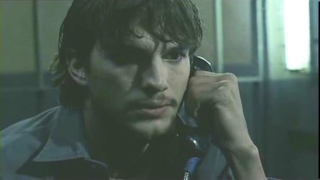 The use of flashbacks in film openings is also a technique
that we liked, and were interested to explore. We had seen this technique used
before, in the opening of The Butterfly Effect, where the main protagonist
could be seen being chased around an office, and being hunted down. At the
time, it was unclear why this was happening, but as the film developed, this
became more obvious. We used a flash-forward in our production, as the opening
we have produced is actually set around 20 years in advance of the rest of the
film. If the film had continued, we would be taken back to the time when the
victim and killer were only very young, to show how she was treated better than
him. The Butterfly Effect is something that we have definitely taken inspiration
from.
The use of flashbacks in film openings is also a technique
that we liked, and were interested to explore. We had seen this technique used
before, in the opening of The Butterfly Effect, where the main protagonist
could be seen being chased around an office, and being hunted down. At the
time, it was unclear why this was happening, but as the film developed, this
became more obvious. We used a flash-forward in our production, as the opening
we have produced is actually set around 20 years in advance of the rest of the
film. If the film had continued, we would be taken back to the time when the
victim and killer were only very young, to show how she was treated better than
him. The Butterfly Effect is something that we have definitely taken inspiration
from. 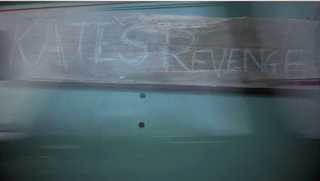 Often in film openings, straight cuts are used to edit the
shots together. This is a good technique to use, as it allows the action to
flow seamlessly, and portrays the fast pace of the action on the screen.
Together with the cross fade, this is a technique we used in our production. Above,
you can see the cross fade in use during our film. Also, the shots are edited
together very quickly, which is something we also tried to use. This technique
works well, because it allows the audience to feel as though they are part of
the action, and raises the adrenaline levels of the audience. Also, the trains
are known for running along the train tracks, so people associate these with
the train.
Often in film openings, straight cuts are used to edit the
shots together. This is a good technique to use, as it allows the action to
flow seamlessly, and portrays the fast pace of the action on the screen.
Together with the cross fade, this is a technique we used in our production. Above,
you can see the cross fade in use during our film. Also, the shots are edited
together very quickly, which is something we also tried to use. This technique
works well, because it allows the audience to feel as though they are part of
the action, and raises the adrenaline levels of the audience. Also, the trains
are known for running along the train tracks, so people associate these with
the train.
Sound is also something that features heavily in the opening
of thriller movies. Non-diegetic sound is almost always the overriding sound element.
Films often use violin/string music, as this works well with making the
audience feel nervous, and as though they are part of the action. This sort of
music was used in the opening of The Butterfly Effect, and also during the
opening of Se7en.
The openings of The Butterfly Effect and Se7en, are ones that
have perhaps inspired our production the most. We like the technique of not
giving much detail away during the film, and also the sound that was used in
these sorts of openings was not dissimilar to our opening.
Above: The Butterfly Effect
Above: Se7en Opening
Many of the conventions of a thriller mentioned above were
applied to our production. Firstly, our production used fast cuts in the edit
to create the feeling of fast-paced action. This helped to build up the feeling
of tension in the audience, and gave the impression that the film was building
up to a climax, where someone might be killed. It also adds to the sense of
confusion, which is also often present in thriller movies.
We have also used a variety of different shot types in our
production. Our shot list shows that our shot choice ranged from extreme close
ups, right the way through to the use of a mid-long shot, although in thriller
movies, long shots are rarely used, as the proximity offered by other shot
types allow the character’s emotion to be relayed to the audience. Furthermore,
the sound we used also had string instruments and drums in, again, something
that is typical of a thriller movie, and the voice we used for the narration
also sounded strong and powerful, which would instil fear in the audience.
Our setting for the film challenged convention, as it was set
at a rural train station, instead of in an urban area. The rural setting for
our thriller was comparable to ‘No Country for Old Men’ by the Coen brothers,
and I feel that this made our thriller unique, and stand out from other films of
a similar genre.
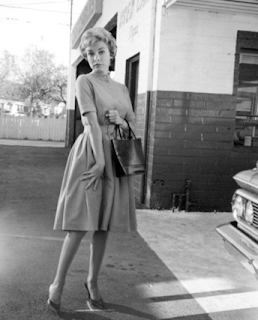
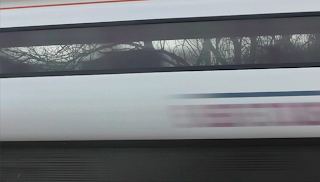 I feel that the cut away shots of the trains we used in our
production were a classic example of a convention used in thriller movies. The
shots were only very brief, and as the diegetic sound was played very high,
each time these train shots came on, it shocked the audience. The shots also
interrupted the narrative of the plot, which made the sequence seem more
interesting to watch.
I feel that the cut away shots of the trains we used in our
production were a classic example of a convention used in thriller movies. The
shots were only very brief, and as the diegetic sound was played very high,
each time these train shots came on, it shocked the audience. The shots also
interrupted the narrative of the plot, which made the sequence seem more
interesting to watch. 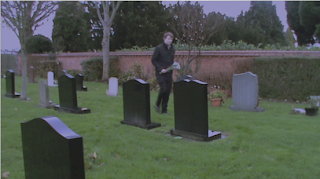 The setting of our production was very important. The
graveyard scene was set in the current time, whilst the train station scene was
a flashback – designed to show the thoughts of the mourner as he laid the
flowers. Graveyards are a typical setting for a thriller movie, and have been
used in many thriller movies, such as The Butterfly Effect.
The setting of our production was very important. The
graveyard scene was set in the current time, whilst the train station scene was
a flashback – designed to show the thoughts of the mourner as he laid the
flowers. Graveyards are a typical setting for a thriller movie, and have been
used in many thriller movies, such as The Butterfly Effect. 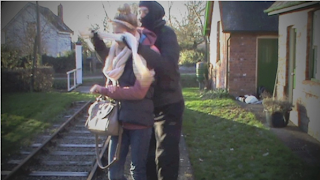
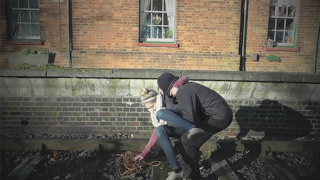 This next shot shows
how the victim was struggling, and that the killer had total control over the
girl. Also, our choice to use a mid-shot to film this section allows the
audience to gather a sense of location, as the railway and the train station
can clearly be seen in the background.
This next shot shows
how the victim was struggling, and that the killer had total control over the
girl. Also, our choice to use a mid-shot to film this section allows the
audience to gather a sense of location, as the railway and the train station
can clearly be seen in the background. 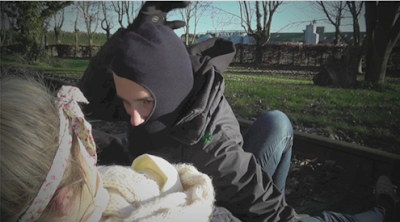 This shot clearly indicates the genre
of the film in the opening section. As the killer begins to remove his
balaclava, the audience get a sense that the film could be about the relationship
between these two people. The use of narration also indicates this throughout
the opening. This shot creates suspense within the audience, as the character
removes the balaclava in a very menacing and sincere way. However, it also
makes the audience intrigued, as they want to know how they are related, and
why the killer was trying to disguise his identity.
This shot clearly indicates the genre
of the film in the opening section. As the killer begins to remove his
balaclava, the audience get a sense that the film could be about the relationship
between these two people. The use of narration also indicates this throughout
the opening. This shot creates suspense within the audience, as the character
removes the balaclava in a very menacing and sincere way. However, it also
makes the audience intrigued, as they want to know how they are related, and
why the killer was trying to disguise his identity. 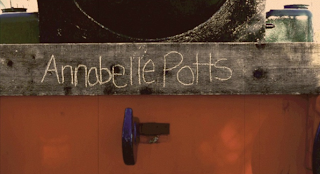 Throughout the film, as the new
actors are introduced, their name appears on a train track, written on by
chalk. This creates the effect that the names have actually been scratched into
the planks. This technique meant that we could avoid using the text overlay in
the editing package we used, as these titles are often quite over-used in
thriller openings. By doing it this way, it meant that we were breaking away
from normal convention, and using a technique that was relevant to the plot of
the thriller opening.
Throughout the film, as the new
actors are introduced, their name appears on a train track, written on by
chalk. This creates the effect that the names have actually been scratched into
the planks. This technique meant that we could avoid using the text overlay in
the editing package we used, as these titles are often quite over-used in
thriller openings. By doing it this way, it meant that we were breaking away
from normal convention, and using a technique that was relevant to the plot of
the thriller opening. 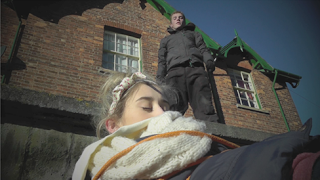 The shot on the left is perhaps my personal favourite in the
whole production. The shot was created by placing the camera on the floor, and
propping the front end of the camera up with a rock. The composition of the
shot means that the killer is standing over the victim, the low angle makes him
seem more powerful, and the dominant figure in the shot. The victim is
unconscious at this point, and she is tied up with a rope, which makes her seem
very vulnerable. Furthermore, the composition of the shot means that the killer
and the victim fill nearly the full height of the frame, whilst ensuring that
the train station is still visible, to remind the audience of the location.
The shot on the left is perhaps my personal favourite in the
whole production. The shot was created by placing the camera on the floor, and
propping the front end of the camera up with a rock. The composition of the
shot means that the killer is standing over the victim, the low angle makes him
seem more powerful, and the dominant figure in the shot. The victim is
unconscious at this point, and she is tied up with a rope, which makes her seem
very vulnerable. Furthermore, the composition of the shot means that the killer
and the victim fill nearly the full height of the frame, whilst ensuring that
the train station is still visible, to remind the audience of the location. 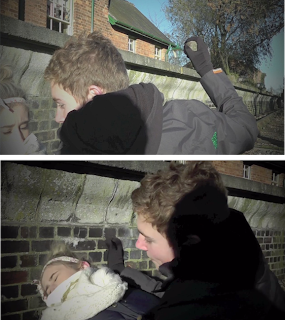 The two shots on the left also show good use of continuity
editing within our production. In total, the two shots were only shown for
three seconds, which shows that we used fast cuts when editing this sequence. This
is to give the impression that our victim was actually knocked unconscious by
the rock, although in actual fact, the rock never touched Annabelle’s face. This
is good evidence of our group using the filming-to-edit technique, which has
been seen in many thriller movies before. The bottom shot also uses the golden
mean, as the victim’s face, the rock and our killer’s face all fall on the same
diagonal line across the frame.
The two shots on the left also show good use of continuity
editing within our production. In total, the two shots were only shown for
three seconds, which shows that we used fast cuts when editing this sequence. This
is to give the impression that our victim was actually knocked unconscious by
the rock, although in actual fact, the rock never touched Annabelle’s face. This
is good evidence of our group using the filming-to-edit technique, which has
been seen in many thriller movies before. The bottom shot also uses the golden
mean, as the victim’s face, the rock and our killer’s face all fall on the same
diagonal line across the frame. 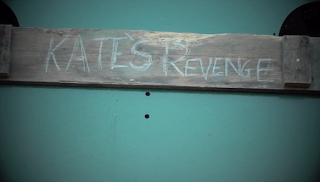 The title of our movie was also something that is quite
conventional for the thriller genre. Usually, the name of the main protagonist
is used in the title of the film, something that was done in the films The
Bourne Identity, The Bourne Supremacy and The Bourne Legacy, as all films star
Jason Bourne as one of the main roles. From watching our thriller opening, the
audience would probably correctly presume that the victim is Kate, who is
killed. However, because the film is called ‘Kate’s Revenge’, the audience
would be intrigued to find out how the film develops, and how she manages to
get revenge on her cousin. The way our title is presented in the film is also
quite conventional for the thriller genre. The title continues with the theme
that runs throughout the opening, with it being written onto the planks.
However, because it is written in chalk, it almost looks as though it has been
written as a child, and as the film develops to go back to the children’s
childhood, this is an appropriate way to present the title.
The title of our movie was also something that is quite
conventional for the thriller genre. Usually, the name of the main protagonist
is used in the title of the film, something that was done in the films The
Bourne Identity, The Bourne Supremacy and The Bourne Legacy, as all films star
Jason Bourne as one of the main roles. From watching our thriller opening, the
audience would probably correctly presume that the victim is Kate, who is
killed. However, because the film is called ‘Kate’s Revenge’, the audience
would be intrigued to find out how the film develops, and how she manages to
get revenge on her cousin. The way our title is presented in the film is also
quite conventional for the thriller genre. The title continues with the theme
that runs throughout the opening, with it being written onto the planks.
However, because it is written in chalk, it almost looks as though it has been
written as a child, and as the film develops to go back to the children’s
childhood, this is an appropriate way to present the title. 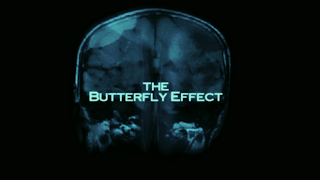 Furthermore, the way of presenting
the title in the centre of the screen with no other action around it is
something that has been done before in films. The film ‘The Butterfly Effect’
used a very similar technique, with the title in the centre of the frame, and
an appropriate background, a brain in this case, behind this. This shows that
our film followed many of the conventions of a typical opening.
Furthermore, the way of presenting
the title in the centre of the screen with no other action around it is
something that has been done before in films. The film ‘The Butterfly Effect’
used a very similar technique, with the title in the centre of the frame, and
an appropriate background, a brain in this case, behind this. This shows that
our film followed many of the conventions of a typical opening. Q2: How does your media product represent particular social groups?
There
are six groups of demographics, listed and detailed below:
Annabelle was dressed as though she would be waiting on a
train. We wanted her to dress in normal everyday clothing, so that the audience
would relate to this character, as many members of the public would usually
travel by train. Furthermore, we also asked Annabelle to wear a watch as a prop,
so that she could be checking the time to see if her train was late. This made
the scene appear more realistic. Annabelle was wearing make-up, again, to make
her character seem more realistic, as though she may be travelling to go and
see someone for the day.
I feel that our media product equally represented many social
groups. Both Men and Women were represented fairly equally, and although the
film used younger actors, I feel that older people would not be offended when
watching our production, as it would appeal to a wide range of age groups.
· Group
A – people in
highly paid jobs, including politicians, bank and large business managers,
doctors, lawyers, scientists and well-paid professionals.
· Group
B – people who are
still well paid, but not as well off as people in Group A, including teachers,
middle managers and civil servants.
· Group
C1 - includes
junior managers, bank clerks, nurses and others in ‘white collar’ professions,
who have a certain skill
· Group
C2 – includes ‘blue
collar’ and skilled trades, such as electricians, plumbers, carpenters &
gas technicians
· Group
D – people who
complete manual work such as builders, drivers and post office sorters
· Group
E – includes people
who are on very low/no income, such as the young, the elderly and people who
are unemployed
The killer in our production, James, could quite easily be
compared to Jason Bourne, who starred in all three films in The Bourne
Supremacy. James’s role in our production was to play the role of a typical
villain – the killer. However, we wanted the killer to be portrayed as quite a
calm and collected person – perhaps someone who is quite philosophical, doesn’t
rush into things, and thinks long and hard about what something before he
actually does it. For example, our group decided that after James had strapped
Annabelle to the railway line, he would be the sort of character who would not
run off from the scene, and instead who would walk off in a calm manor.
In a lot of the thrillers we have watched, males are usually
considered to be the killers, as stereotypically, men are the gender who are
considered to be powerful and strong. In addition, James is a young teenager,
and men who are quite young, perhaps under 40, are the people who usually kill
people.
We wanted James to be wearing something that a typical killer
would be seen in. We decided that he would wear a black balaclava, to ensure
that his face would be hidden from his victim, creating an element of
mystery. In all of the films we have
studied, the killers usually wear black clothing, which symbolises danger and
death. In a similar way, mid and long shots were usually used to film this
character, to try and hide his identity from the audience, which again, creates
the element of mystery and unknown. However, when James revealed himself to our
victim, a close up shot-reverse-shot was used to film this, as it allowed the
audience to relate with the character, and also showed the emotion of both of
the characters.
James used a gag to tie Annabelle’s mouth up with during
filming. This was a significant prop, as it made Annabelle helpless and unable
to move, which made her seem vulnerable, and allowed the audience to feel
sympathy for her. Also, James used some rope to tie Annabelle down to the train
track with, and this was a good prop for him to use, as many may associate a
rope with being helpless and in danger.
Because of the budget our production was made on, we did not
need to use make up or lighting for this character.
Our second main actor, Annabelle Potts, played the role of
the victim in our production. We wanted someone to take this part on who could
use good facial expressions, and who would look very innocent when waiting for
the train to come. She could be likened to the woman was in the shower scene
from Hitchcock’s Psycho film.
Typically in the films that we have watched, females are the
victims, as they are usually seen as being a less dominant gender in society.
Also, the age of Annabelle fitted in with our plot - it is entirely plausible
that Annabelle and James could be cousins. Furthermore, Annabelle’s slim figure
made it easy for James to lift her over his shoulder in some scenes!
Q3: What kind of media institution might distribute your media product and why?
Our group chose the name JJCM Productions, as it encompasses
the first initial of all of our names. In addition, the name is simple and
effective. Our production ident that appeared at the beginning of the thriller
consisted of each of the letters appearing on the screen with a straight cut,
and each time a letter appeared, a bang could be heard. This meant that it was
grabbed the audience’s attention, and adopts our ethos of creating films with a
strong, powerful message.
It is the role of a production company to sell, market and
produce the film that we produce. The production company also assist in the
creation of the film, by helping with the budget, scheduling and scripting. In
addition, they also get involved with casting the actors to star in the
production. Furthermore, they are also involved with commissioning the
director, and other members of the crew.
A production company would own the rights to the film, and would
receive a commission every time the film is watched in a cinema or sold on a
DVD or Blu-Ray disc. Therefore, they would use the money that they have earned
over the years on other projects to fund a production. Furthermore, the
production company would also use advertising to make money, and to sell the
finished film.
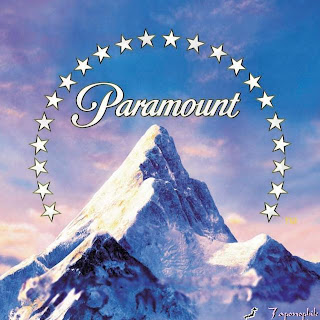 I feel that Paramount
Pictures would be the best institution to produce, distribute and market our
thriller. Founded in 1912, the company are based in the Los Angeles district of
Hollywood, and are the fourth oldest existing production company. Their base in
the US means that if our film were distributed through Paramount Pictures, it
would be able to reach bigger audiences, and it would be seen globally in
countries including the US and the UK, where are if we went for a UK based
company, the film may only reach a smaller proportion of our target market.
I feel that Paramount
Pictures would be the best institution to produce, distribute and market our
thriller. Founded in 1912, the company are based in the Los Angeles district of
Hollywood, and are the fourth oldest existing production company. Their base in
the US means that if our film were distributed through Paramount Pictures, it
would be able to reach bigger audiences, and it would be seen globally in
countries including the US and the UK, where are if we went for a UK based
company, the film may only reach a smaller proportion of our target market.
Paramount Pictures are a subsidiary company of Viacom, who are an
American based global mass media company, with interests in both film and
television. Again, this would be of advantage to us, as it would allow our film
to receive adverts on Viacom’s television channels.
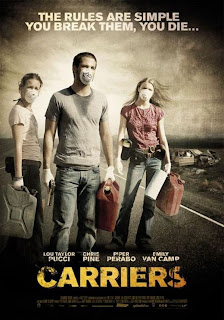 Paramount Pictures have produced many thriller films in the past,
including Snake Eyes, Carriers and Hard Rain. They also have experience in
other genres, including action, sci-fi and horror. Their experience in creating
these sorts of films means that our production would fit into their remit perfectly,
as they have experience in producing thriller movies, along with other genres
which have small elements present in our production.
Paramount Pictures have produced many thriller films in the past,
including Snake Eyes, Carriers and Hard Rain. They also have experience in
other genres, including action, sci-fi and horror. Their experience in creating
these sorts of films means that our production would fit into their remit perfectly,
as they have experience in producing thriller movies, along with other genres
which have small elements present in our production. Their experience with thriller films would mean that they would be able to offer lots of advice into our thriller, and their position, based in Hollywood, would mean that our film would be able to reach a mass audience around the globe. Additionally, their links with Viacom, a major television media company, would mean that our film would be able to be marketed very effectively, to the right audience.
It is very important to ensure that the credits are put in the right
order during the title sequence and during the closing sequence. The table
below compares the standard order for credits with the order the credits were
presented in our production:
Standard order for Credits in a film
|
Our Film
|
Production Ident
[PRODUCTION COMPANY] Presents
[FILM TITLE]
Lead Cast Supporting Cast Casting Director Music Composer Costume Designer Associate Producers Editor(s) Production Designer Director of Photography Executive Producer Producer Writer(s) Director |
Production Ident
Presents
Kate’s Revenge
Connor Marshall
Annabelle Potts
James Craig
Directed by Matthew Bostock
Edited by James Parronchi
Narrated by Henry Saunston
|
Q4: What would be the audience for your media product?
To decide the target audience of our
film, we carried out lots of research into the audience. We carried out
research into the following psychographic groups:
After carrying out this research, we have decided that those who are
Explorers and Resigned would most want to watch our film. This is because they
are most likely to be the sort of people who like adventure and action, which
is something that is included in our production.
 Our research told us many things. Firstly, 31.25% of our audience like
films which include an element of comedy, and this is something that we could
try and include in our film, if we were given the opportunity to continue
production. Furthermore, people also go to the cinema quite regularly, so our
production company should be able to get the film into UK cinemas, as well as
producing it on DVD.
Our research told us many things. Firstly, 31.25% of our audience like
films which include an element of comedy, and this is something that we could
try and include in our film, if we were given the opportunity to continue
production. Furthermore, people also go to the cinema quite regularly, so our
production company should be able to get the film into UK cinemas, as well as
producing it on DVD.  Also, our audience, especially boys, expect death to be something that
is included in the film. In fact, 100% of our audience likes films that involve
death, which shows us that both males and females like to watch films that
include this sort of content. With this in mind, we decided that the victim
should be killed by the train. Our research also told us that they like a plot
where they have to concentrate on the plot, which is why we decided that the
narration would not give too much information away, and so the plot becomes
clear as the film develops.
Also, our audience, especially boys, expect death to be something that
is included in the film. In fact, 100% of our audience likes films that involve
death, which shows us that both males and females like to watch films that
include this sort of content. With this in mind, we decided that the victim
should be killed by the train. Our research also told us that they like a plot
where they have to concentrate on the plot, which is why we decided that the
narration would not give too much information away, and so the plot becomes
clear as the film develops.  The British Board of
Film Classification (BBFC) are an independent body of people, not linked to the
government, who provide legal classification for films sold in the UK. The body
is designed to bring a degree of uniformity to the film classification
industry, and although local councils can override decisions made by the body,
their decision is often respected.
The British Board of
Film Classification (BBFC) are an independent body of people, not linked to the
government, who provide legal classification for films sold in the UK. The body
is designed to bring a degree of uniformity to the film classification
industry, and although local councils can override decisions made by the body,
their decision is often respected.
Each film submitted for certification by the BBFC is assessed by at
least two examiners. Usually, the examiners are able to come to a decision
about a film, but if disagreement or complex policies are included, then a
decision may have to be made by senior directors. Examines focus on issues such
as language, sexuality, nudity, discrimination, drugs, behaviour that can be
copied, horror, violence and theme when making their decision, the context is
something that is carefully considered. For example, if it is important to show
nudity for educational purposes, then the film would usually be given a lower
classification. The release format is often considered, as if a film is
released on DVD or film, then there is a higher opportunity for underage or
repeated viewing.
BBFC examiners have seven different classification certificates
available to issue, and these are listed and detailed below:
· U– Universal, meaning
that the film is suitable for all age groups. It is advised that the films are
set within a positive moral framework, and that violence or horror should be
reassuringly counterbalanced. Discrimination is not permitted, and only infrequent
and innocuous reference to drugs and alcohol may be used. Films should only
contain brief and mild scenes of horror, and none of the behaviour or actions
in the film may be copied. No sexual content may be displayed, and only
occasional natural nudity is permitted.
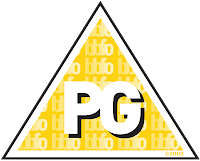 · PG– parental guidance,
meaning that some scenes may require advice and support from parents or
guardians. Generally, these films should not disturb children over eight years
of age, but parents should consider if sensitive children may be disturbed. If
reference to drugs is mentioned, a relevant anti-drug message should be
carried, and horror sequences should not be prolonged or intense. Only mild bad
language should be included, and sexual activity can only be implied. Moderate
violence, if justifiable, is allowed.
· PG– parental guidance,
meaning that some scenes may require advice and support from parents or
guardians. Generally, these films should not disturb children over eight years
of age, but parents should consider if sensitive children may be disturbed. If
reference to drugs is mentioned, a relevant anti-drug message should be
carried, and horror sequences should not be prolonged or intense. Only mild bad
language should be included, and sexual activity can only be implied. Moderate
violence, if justifiable, is allowed.
· 12/12A– exactly the
same criteria is used for both 12 and 12 A films, although 12A certificates are
issued for films in cinemas, where no-one under this age is permitted to watch.
Discriminatory work must not be endorsed by the films message. Drug use should
be infrequent, and instructional details should not be given. The film should
not dwell on behaviours that can be copied by the audience, and the use of
moderate language is allowed, although its use should be infrequent. Sexual
references can be briefly portrayed, although the activity should not go beyond
what is suitable for young teenagers. Moderate violence is allowed, although it
should not dwell on gory details
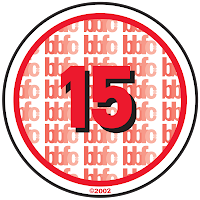
· 15– Discriminatory
language or behaviour must not be endorsed, and drug misuse can be shown,
although the misuse should not be endorsed. Dangerous behaviours (such as
hangings) should not dwell on details which can be copied, and frequent use of
strong language is allowed. Aggressive or repeated use of strong language
should not be encouraged. There are no constraints on nudity in an educational
setting, and violence may be strong, and should not dwell on the infliction of
injury.
· 18– 18 films usually
observe the fact that adults should be free to choose their own entertainment.
Therefore, films will only not be granted licence when the material has been
created through breach of a law, where material appears to risk harm to
individuals or the public through the imitation of behaviour, and where the use
of explicit images cannot be justified by the context.
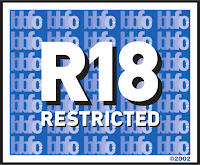 · R18– can be shown only in specially licenced cinemas, or supplied in
specially licenced shops. The following is not acceptable: material that is in
breach of criminal law, obscene material, material likely to encourage an
interest in sexually abusive activities such as rape, the portrayal of sexual
activity which does not include consent, the infliction of pain, the
penetration of any object associated with harm, or any sexual threats or
humiliation which do not clearly define part of the plot.
· R18– can be shown only in specially licenced cinemas, or supplied in
specially licenced shops. The following is not acceptable: material that is in
breach of criminal law, obscene material, material likely to encourage an
interest in sexually abusive activities such as rape, the portrayal of sexual
activity which does not include consent, the infliction of pain, the
penetration of any object associated with harm, or any sexual threats or
humiliation which do not clearly define part of the plot. From the research I have carried out, I can therefore see that thriller films are usually given one of the higher rating available by the BBFC, because of the content included, which includes violence, strong language and nudity, that makes them a thriller film. This tells me that Thriller films are likely to only be suitable for older, more mature audiences, and therefore we should target our film at older viewers.
I feel that if we were planning on submitting our thriller to the BBFC, we should be aiming to receive a 15 certificate. This is because of the fact that we are implying someone will be killed in our film, which would be classed as moderate use of violence. This also fits in with our target audience, which we would anticipate would be between ages 15-30. However, our film will not contain any sexual references or scenes, and no strong language will be used, which is why I believe that it would not be appropriate for 18 classifications. However, our film contains some mature themes, such as the idea of death and murder, which would not be appropriate for younger audiences, in my opinion. Our 15 classification meant that we focused some of the themes and issues people of this age face. For example, they may be facing a situation where one sibling/cousin is treated better than another due to favouritism, and I feel that our film would appropriately address these issues, whilst ensuring that the way they are presented is appropriate for the audience.
Subscribe to:
Comments (Atom)








